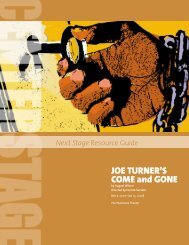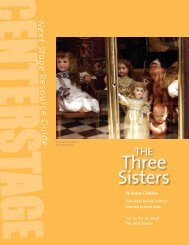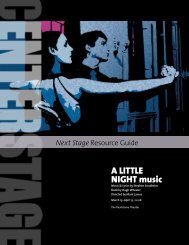The Matchmaker - Center Stage
The Matchmaker - Center Stage
The Matchmaker - Center Stage
You also want an ePaper? Increase the reach of your titles
YUMPU automatically turns print PDFs into web optimized ePapers that Google loves.
Glossary<br />
continued<br />
Presbyterian<br />
Presbyterianism is a form of Calvinist Protestantism that<br />
originally comes from Great Britain (particularly Scotland and<br />
Ireland) that sought to replace the episcopal system of stateappointed<br />
bishops with a group of church elders appointed by<br />
the people, or a presbytery. Culturally, it has been characterized<br />
traditionally by a rigid asceticism, and fundamentalist or<br />
evangelical offshoots continue to be popular. In America, the<br />
Presbyterian church traces its roots back to the 17 th century<br />
New England Puritans, who merged with Scots, Welsh, and<br />
Irish-founded churches from Maryland, Delaware, and<br />
Pennsylvania in 1706s Presbytery of Philadelphia. <strong>The</strong> Church<br />
grew throughout the 18 th and 19 th centuries, largely aided by<br />
the influx of Scottish, Irish, and Welsh immigrants. As Wilder<br />
noted in a 1956 interview, his own upbringing in Wisconsin was<br />
overseen by “a very strict Calvinistic father,” and he attended<br />
Oberlin College in Ohio “when the classrooms and student life<br />
carried a good deal of the pious didacticism that would now be<br />
called narrow Protestantism.”<br />
Tenting tonight; tenting tonight;<br />
tenting on the old camp ground<br />
“Tenting on the Old Camp Ground” is a popular song written in<br />
1863 by Walter Kittredge. Traditionally sung by enlisted men in<br />
the Union army, it is unusual for its time due to its melancholy<br />
tone and its explicitly articulated desire for peace and an end<br />
to war. Though popular in the South, it was never published<br />
below the Mason-Dixon line.<br />
Raritan Canal<br />
A canal in central New Jersey, built in the 1830s to connect<br />
the Delaware and Raritan Rivers, the Raritan Canal was an<br />
important means of transporting freight (especially coal) from<br />
eastern Pennsylvania to New York City, especially in the era<br />
before the railroads. Cornelius Hackl is being positioned as<br />
nouveau riche American aristocracy, a 19 th -century industrialist<br />
in the mold of Vanderbilt, Rockefeller, or William Randolph<br />
Hearst.<br />
the early ‘80s<br />
Commonly known as the Gilded Age, the period from 1877<br />
to 1893 was one marked by extreme wealth, population<br />
expansion, and a general feeling of national resurgence<br />
following the Civil War era (1861–65) and Reconstruction. A<br />
number of New York City landmarks built during the era persist<br />
to this day as symbols of the era’s sense of monumentalism<br />
and optimism:<br />
•<br />
•<br />
•<br />
•<br />
•<br />
Grand Central Station (opened in 1871)<br />
Central Park (completed in 1873)<br />
the Brooklyn Bridge (finished in 1883)<br />
the Statue of Liberty (given to New York City in 1886 by<br />
France as a commemoration of the 1876 Centennial),<br />
the Ellis Island Immigration Station (opened in 1892).<br />
<strong>The</strong> next phase in New York City’s growth as a city would come<br />
in 1898, when the five boroughs of Manhattan, the Bronx,<br />
Brooklyn, Queens, and Staten Island were unified as one city,<br />
and Robert Anderson Van Wyck was elected New York City’s<br />
first Mayor. <strong>The</strong> New York City subway system would open in<br />
1904, and New York would pass London as the most populous<br />
city in the world in 1925.<br />
the Harmonia Gardens Restaurant on the Battery<br />
<strong>The</strong> Battery, located on the southern tip of the island of<br />
Manhattan, is the strategic geographical point, at the head of<br />
the Hudson River and New York’s harbor, at which the history<br />
of New York begins. <strong>The</strong> Dutch colonists began the settlement<br />
of New Amsterdam here in 1625, the northernmost wall of the<br />
small outpost eventually becoming modern-day Wall Street.<br />
<strong>The</strong> Battery’s name derives from the artillery batteries which<br />
have been stationed there since the Dutch built one around<br />
1683. Though this area of the city is now a financial center filled<br />
with skyscrapers, in the nineteenth century it was a popular<br />
promenade with a spectacular view of the harbor, at the time<br />
among the busiest in the world, and many wealthy merchants<br />
lived downtown in order to be close to their holdings. Castle<br />
Clinton, the circular fort built 200 feet offshore of Battery Park<br />
by the English between 1808 and 1811, served as New York’s<br />
federal immigration center from 1855 to 1890, until the opening<br />
of Ellis Island. No restaurant by the name of Harmonia Gardens<br />
can be found in the historical record, and the title instead<br />
appears to be Wilder’s allegorical invention. <strong>The</strong> title suggests<br />
the romantic symmetry characterizing the play’s latter half<br />
(Harmonia), as well as the archetypal comic Arcadia in which<br />
class and status inversions are possible (Gardens).<br />
<strong>The</strong> Merchant of Yonkers<br />
<strong>The</strong> Merchant of Yonkers was completed in the months after<br />
Our Town premiered on Broadway (February–March of 1938),<br />
and has lingered ever since in the shadow of its revered<br />
predecessor. <strong>The</strong> initial production premiered on Broadway<br />
on December 23, 1938 under the direction of Max Reinhardt,<br />
the commercial genius of interwar German theater (and<br />
also Wilder’s boyhood hero). It would close after a mere 39<br />
performances, the worst failure of Wilder’s professional<br />
career. Rewritten in 1954 and retitled <strong>The</strong> <strong>Matchmaker</strong>, the<br />
subsequent production, directed by Tyrone Guthrie and<br />
starring Ruth Gordon as Dolly Gallagher Levi, would run for 486<br />
performances from 1955–56, by far the most successful run<br />
of Wilder’s career. <strong>The</strong> different receptions of the two works<br />
(essentially the same play) appears to have been decided by<br />
Guthrie’s sympathetic staging of the text, energetic where<br />
Reinhardt’s was temperately paced, idiomatically American<br />
rather than Teutonically ostentatious. Wilder, however,<br />
dedicated the 1939 publication of <strong>The</strong> Merchant of Yonkers and<br />
the 1955 published version of <strong>The</strong> <strong>Matchmaker</strong> to Reinhardt,<br />
“with deep admiration and indebtedness.”<br />
<strong>The</strong> Sidewalks of New York<br />
Also known as “East Side, West Side” from the song’s first verse,<br />
<strong>The</strong> Sidewalks of New York is a popular song about New York<br />
City life written by lyricist James W. Blake and vaudeville actor<br />
Charles B. Lawlor in 1894. Now a jazz standard, the song is<br />
Next <strong>Stage</strong>: <strong>The</strong> <strong>Matchmaker</strong> | 1









